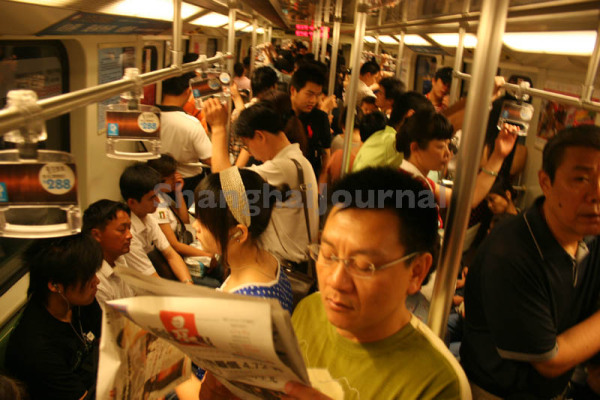
I read the news today oh boy…wait, I didn’t have to read the news, because I’m here. In China, at last! After several months of beta testing, this site finally goes LIVE. Yes, folks, I’ll be here for the next several months, your roving reporter of the CHINA SCENE. Though I’ll be busy the next few months, especially after the Dartmouth FSP program kicks off this September, I fully intend to keep posting my impressions and reflections on what’s going down in the P R of C as it revs up for the OLYMPICS.
This week I’m coming at you live from SHANGHAI, and since this is the Shanghai Journal after all, I’ll make the most of my time here to familiarize myself, and you, with the latest word from the street. After that it’s up to BEIJING, where I remain for the rest of the year, barring a few trips now and then to other places.
So, what went down this weekend?
Woke up, fell out of bed, dragged a comb across my head. I’m probably in major copyright violation by now and Michael Jackson’s lawyers are on my ass, so I’d better stop quoting Beatle lyrics and get on with it.
Yesterday (Saturday) I got on the subway at Yanchang Road (where we’re staying) and headed down to Xujiahui. My goal: to buy a new mobile phone. Once the Mecca of Catholicism for China (it was here that “Paul” Xu Guangqi, one of China’s earliest and most influential converts, had his home in the late Ming period) Xujiahui has been transformed in the past decade into the shopping Mecca of Shanghai. A bustling beehive of intensity and activity—markets of all sorts converging and disbanding on the streets and in the vast warren of rabbit tunnels in the underground. Four major department store/shopping centers square off on the corner of Huashan and Zhaojiabang Road.
I head into the Ganghui Guangchang, the massive mother ship of shopping malls in Shanghai, with its great atrium and glass-and-steel vaulted ceiling, this is the dream Paris dreamed in the early nineteenth century with its Arcades (later reincarnated by a highly imaginative, hashified soul named Walter Benjamin)—the unfinished project of modernity (who said the world is “postmodern”? modernity is still going strong folks) as we make our way up six floors of retail space to the phone section. So many to choose from—how does one differentiate between all those models, brands, functions? So much sameness hiding behind so much diversity—wait, wasn’t that somebody’s definition of modernity? I end up going for the Sony Ericsson Cyber-shot K550c. Takes decent photos. Good interface. Stores numbers. Looks cool. Feels sleek and elegant. What more could you ask for?
Armed with my new toy/tool/cool/styling GADGET, I head down the escalator, madly keying in functions, trying to figure out how the damn thing works, heading down, down, into the belly of the beast, the writhing body-infested labyrinth of the Xujiahui underground, where I make my way through the tunnels to the other side of the intersection, past swarms of waidiren on the make, selling whatever fell off the truck that day, then walk up Hengshan Road (formerly Avenue Petain)—one of my favorite strolling streets, with its plane-tree canopy (it’s a breezy, cool day anyhow—nothing like the usual sultry Shanghai summer) heading up the blocks to my next destination:
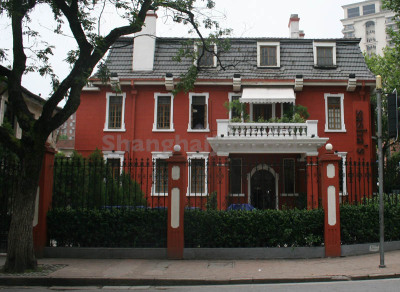
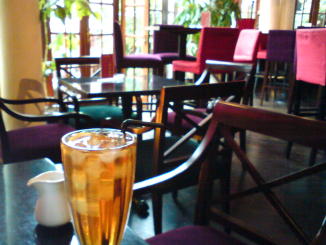
Sasha’s on the corner of Hengshan and Dongping Road. This restaurant was built out of an old mansion that once housed none other than T.V. Soong, the brother of the infamous Soong Sisters and finance minister to the G’issimo. In the late ‘90s an enterprising European bought it up, evicted whoever was living there and turned it into a posh restaurant and bar. A great place to kick back for the afternoon and catch up on my emails and other work while soaking in the ghosts of T.V. and his sisters. Like many spots around town that cater to the X-pat crowd, it features free wireless internet (not like f’in’ Starbucks, where you have to buy a special card to use the Net). I purchase a token ice tea (token my ass—that’s 35 RMB down the tubes at 6.5 RMB to the AUD, around 5 bucks, not too bad I guess) and sit down to read my emails.
Then another stroll down another favorite avenue of mine, Fuxing Road (Ave. Lafayette), all the way over to the Ruijin Guesthouse, where I’m scheduled to meet the wife, kid, and grandfolks for dinner at Xiao Nan Guo, a popular Shanghai-style restaurant. A wedding party is in full swing, and Sarah watches with glee as the bride and groom go round the guests’ tables (they’re cordoned off from the rest of us) and light off sparklers on each table with a long thin candle. “Fireworks!” she squeals. We suffer through a few minutes of loudspeaker-enhanced wedding shenanigans and dig into our meal. Sweet, sweet Shanghai cuisine. Then it’s back home—early to bed early to rise for this jetlagged, flu-recovering soul. No carousing for Dr. Nightlife this weekend, I’m afraid.
Nothing like Shanghai on a cool summer Sunday. The traffic is at its lowest of the week, and the streets of old Frenchtown are nearly empty. Everyone is either resting at home or in one of the city’s many shopping malls. Great time to be a FLANEUR, strolling along the streets at a turtle’s pace, soaking in the sights, smells, and sounds. Once again I brave the N-S subway line. Not quite as dense a crowd as the day before.
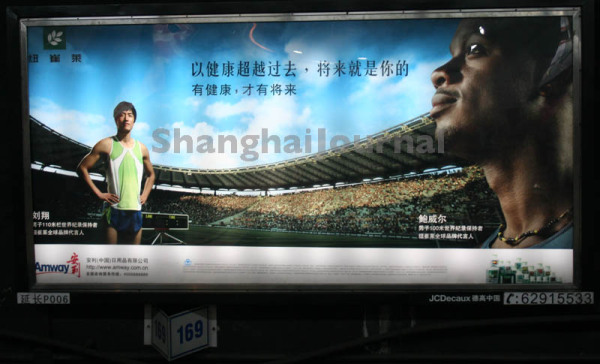
I notice an ad at the Yanchang Road station. The juxtaposition of the Chinese and African athlete (who cares if he’s American—to Chinese eyes he’s clearly a heiren) strikes me as significant. The sign reads, “With health leap beyond the past—the future is yours.” A subtle reminder of the growing importance of Sino-African relations? A subtle message to the white man: this world is no longer yours to rule. Echoes of Maoist imagery from the ‘50s. But now China’s relationship with Africa has changed from “concerned brother” to “greedy uncle.”
On the corner of Changshu Road and Huaihai Road is a construction site. These are getting rarer in the center of the city—still plenty of building on the peripheries—but it’s no high-rise, rather a new subway station that’s being built here, folks.
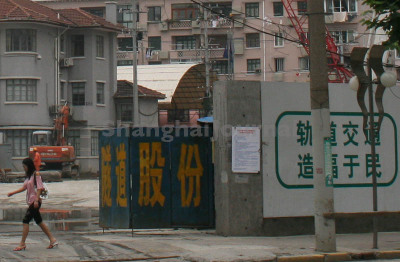
Yes, Shanghai is going nuts for the underground. Over the next few years, they’re laying down dozens of lines (don’t recall the official number, maybe that’s a slight exaggeration) but they’re tearing up the city to increase the subway lineage, and bulldozing anything that’s in the way. Not many buildings from Old Shanghai remain, except for the ones marked for preservation by the city government. Fortunately there are quite a few of those, more in the French Concession than the International Settlement (divided nicely by the Gaojia over Yanan Road formerly Avenue Edward VII – Avenue Foch). Each preserved building has a plaque stating its original name and sometimes a fairly detailed history of the building in Chinese.
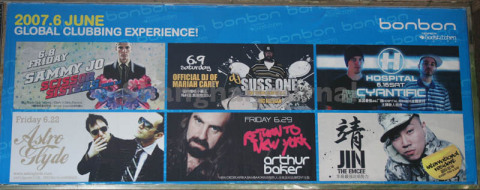
Heading down Baoqing Road I pass the former Maya Club, an old sometime hangout of ours, now called Bonbon. I pause to snap a photo of the clubbing sign on the building—if it weren’t for the Chinese writing under the DJ Jin, this could be anycity. Just goes to show that Shanghai is now an integral node in an international clubbing circuit, with big-named DJs stopping in to play the city’s clubs on their Asia tours. This is a very recent development, by the way, really a product of the 2000s.
I stroll down to Sasha’s, where I get some work done, and then head over to nearby Taojiang Road and O’Malley’s one of the first “authentic” (as if that word could have any meaning these days) Irish Pubs in Shanghai. Over the years they’ve broadened from the nightly X-pat/hip Chinese drinking crowd to a money-making combination of sport lovers and families by day, drinkers by night. The pub is conveniently walled in, and they’ve turned the front lawn into a playground for kids, equipped with some real cool jungle gyms. Great place to take a toddler and let her roam without worrying too much. A group of Chinese men guards the front gate, making sure the kiddies don’t get out.
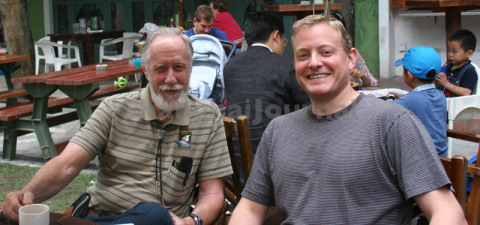
Mency and Sarah are waiting for me, and so is my old mate Gary Flint. Haven’t seen Gary in a while so we spend the afternoon catching up. Gary is an old Japan hand who made his way to China a few years ago and runs a fantastic website called Mountainsongs. It’s a collection of Chinese poems with English translations (he’s been working with some of the best translators in the biz), all tied to famous mountains, temples, and other sacred sites, which he has been to and photographed. Half the time he’s off in some remote region of China taking photos of an obscure temple that Du Fu just happened to visit and write a poem about, or else following the peregrinations of an eminent monk from an age gone by. The rest of the time he’s hanging out in cool spots in Shanghai building his website, or else playing country music in a local pub. I hope I’m in half as good shape as he is by the time I’m in my golden years, but the way my health is going, I’ll be lucky to reach the half-century point.
I catch Gary reading a book in Japanese—turns out to be the biography of a famous Japanese monk, Saicho, who traveled to China in the Tang dynasty and brought Tendai Buddhism back to Japan. Ah, the Tang, what a glorious age. We talk about the tangled superiority-inferiority complex that has influenced Sino-Japanese relations for the past millennium and a half. Sarah runs up, proud that she’s made it across the “spider web bridge” of the jungle gym, but Daddy’s too busy catching up with an old friend. Mency takes a tired, struggling Sarah home.
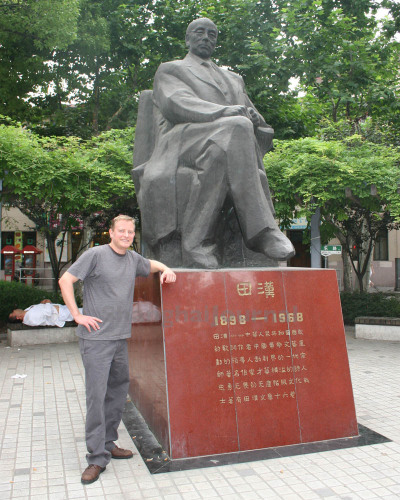
Gary and I stroll northward toward his neighborhood. At the corner of Fumin Road and Xinle Road, we pause to snap a photo of the statue of Tian Han, famous playwright of the 1930s, who penned the words to the Chinese national anthem—“stand up, not-wanting-to-be-slaves Chinese, with our blood and flesh let’s build a new Great Wall” (wonderful image, by the way).
I know these streets like the back of my hand. I love the way they wind around, heading off in this or that direction without any apparent plan, sort of like the streets of my old homecity, Boston.
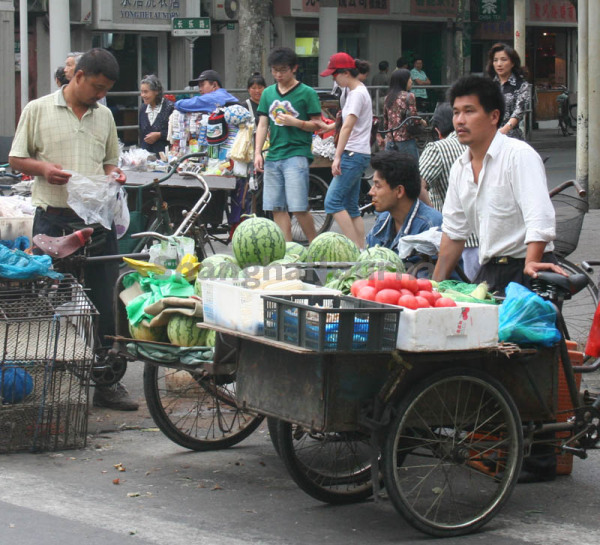
I’m surprised to find a vibrant street market at the corner of XXX Road and YYY Road—I thought these were outlawed years ago. Back in the late ‘90s the government swept these markets into warehouses where they could keep better control over them. Now in the wake of major layoffs of the preceding years, street markets are back. I ask a woman selling vegetables if this is a legal market. She doesn’t answer directly but says that the police “look the other way.” “We’ve been laid off—what else can we do?” Can’t argue with that.
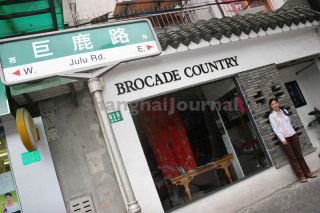
Our next stop is Brocade Country at 616 Julu Road. This is a small shop that specializes in clothing and embroidery work made by the tribes of Guizhou.
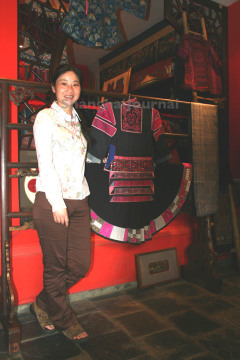
The owner, Xiaolan, is a friend of ours. Every three months she heads out to Guizhou to restock her supplies. Elsewise she’s at her store seven days a week. Word has got out and her place is now well known amongst the X-pat community. Beautiful antiques, clothing that once had magical efficacy, painstakingly hand-stitched by loving mothers, wives, daughters, used in important ceremonies that knit tribes together in a visual language rapidly being forgotten, now hanging on the walls of well-to-do urban Chinese and X-pats. A culture commodified, another casualty of capitalism? At least these things are being preserved, runs the counter-argument. Also, these tribes are earning money, which they desperately need. All in all, I’d say that Xiaolan is doing a good deed while turning a tidy profit. But she has little time for chit-chat—she’s too busy catering to the X-pat wives, so we leave her alone.
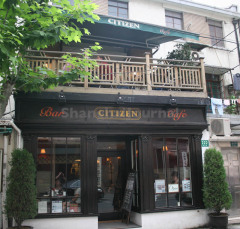
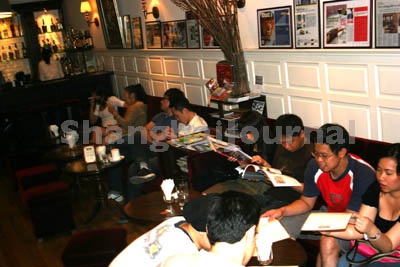
We head for Gary’s favorite local hangout, a coffeeshop called Citizens Cafe. A recent addition to the Shanghai scene. Nice place. Definitely takes advantage of Old Shanghai architecture to offer a semi-European café experience. The crowd is mostly Chinese. Are revolutionary plots stirring amidst the lattes and capucinos? Unlikely. The buzz is all about business and pleasure.

The verandah on the second floor makes the place, though the chairs could be sturdier. I slake my thirst with a Mojito while we continue catching up. Gary has great ambitions for his website. He’s constantly behind schedule, even though he now has a small team of people working on it. What a great legacy to leave the world—the sacred mountains of China immortalized by China’s greatest poets and their English translators. A virtual world to explore, for hour upon hour. We’re skeptical that anybody would spend that much time on one site on the Net. After all, the Net’s about DISTRACTION, not engagement, isn’t it? Hopping from one site to another without staying long. Making chit-chat here and there, then moving on. Sort of like strolling through a virtual city.
If you’ve made it this far through my blog, I congratulate you on your endurance.